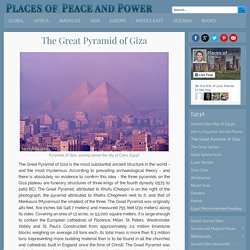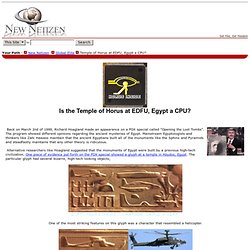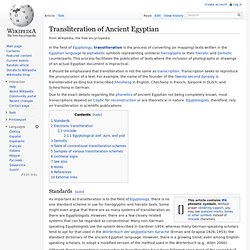

Outer Stone of Egypt's Bent Pyramid is Artificial! - Journal - Bosnian-Pyramid. The Official Website of Robert Bauval - Home Page. Egypt - The Lost Civilisation Theory. The Panleonist Lost Civilisation Theory The panleonist theory proposes that a highly advanced civilisation existed on the Earth during during the precessional age of Leo (c. 10900-8700 BC), but was destroyed by a cataclysm circa 10500 BC and hence became a ‘lost civilisation’. The theory proposes that the lost civilisation encoded the date 10500 BC into their monuments (e.g. by astronomical alignments) so as to commemorate the date of the cataclysm.
The panleonist theory is best known from the writings of Robert Bauval, Adrian Gilbert and Graham Hancock. But it has its roots in an assortment of different writings. Firstly, in Plato’s story of Atlantis, which recalled the destruction of an advanced civilisation nine thousand years before the time of Solon, i.e. c. 9600 BC. It is on the writings of Bauval, Hancock and Gilbert that I wish to comment here, in particular their claims that the Giza Pyramids and Sphinx were built to commemorate the date 10500 BC. Ian Lawton and Chris Ogilvie-Herald's Giza the Truth: The People, Politics and History Behind the World's Most Famous Archaeological Site. The multitude of popular works that have been published about the Giza Plateau - home of the three most famous pyramids and the Sphinx - have increasingly painted a picture of impossible engineering, extreme antiquity, and 'lost' ancient civilisations.

Bolstered by a variety of television documentaries, this 'alternative' view has now become firmly entrenched in the public consciousness, leaving the orthodox Egyptological cause floundering in its wake. But have the public been misled, especially in the run up to the new millennium? Coming at a time when more enlightened observers are beginning to question the barrage of propaganda emanating from the alternative movement, the publication of Giza: The Truth is perfectly timed to redress this imbalance. Is it genuinely possible that a Hall of Records containing a record of ancient civilisations exists at Giza?
That the remnants of these civilisations designed and built the pyramids and Sphinx as much as 12,000 years ago? Revelations! The Great Pyramid of Giza. Pyramids of Giza, soaring above the city of Cairo, Egypt The Great Pyramid of Giza is the most substantial ancient structure in the world - and the most mysterious.

According to prevailing archaeological theory - and there is absolutely no evidence to confirm this idea - the three pyramids on the Giza plateau are funerary structures of three kings of the fourth dynasty (2575 to 2465 BC). The Great Pyramid, attributed to Khufu (Cheops) is on the right of the photograph, the pyramid attributed to Khafra (Chephren) next to it, and that of Menkaura (Mycerinus) the smallest of the three.
The Great Pyramid was originally 481 feet, five inches tall (146.7 meters) and measured 755 feet (230 meters) along its sides. Covering an area of 13 acres, or 53,000 square meters, it is large enough to contain the European cathedrals of Florence, Milan, St. Archaeologists uncover 3,500-year-old Egypt city. Lost Technologies of Ancient Egypt (Build 20100722155716) Is the Temple of Horus at EDFU, Egypt a CPU? Is the Temple of Horus at EDFU, Egypt a CPU?

Back on March 2nd of 1999, Richard Hoagland made an appearance on a FOX special called "Opening the Lost Tombs". The program showed different opinions regarding the ancient mysteries of Egypt. Mainstream Egyptologists and thinkers like Zahi Hawass maintain that the ancient Egyptians built all of the monuments like the Sphinx and Pyramids and steadfastly maintains that any other theory is ridiculous.
Alternative researchers like Hoagland suggested that the monuments of Egypt were built by a previous high-tech civilization. One piece of evidence put forth on the FOX special showed a glyph at a temple in Abydos, Egypt. One of the most striking features on this glyph was a character that resembled a helicopter. This glyph was found in a Temple that was originally built by Seti the 1st in Abydos which was a cult center dedicated to the worship of Osiris.
On this same web page was a map of the Temple of Horus. Copyright © 2001 New Netizen. Transliteration of Ancient Egyptian - Wikipedia, the free encycl. In the field of Egyptology, transliteration is the process of converting (or mapping) texts written in the Egyptian language to alphabetic symbols representing uniliteral hieroglyphs or their hieratic and Demotic counterparts.

This process facilitates the publication of texts where the inclusion of photographs or drawings of an actual Egyptian document is impractical. Due to the exact details regarding the phonetics of ancient Egyptian not being completely known, most transcriptions depend on Coptic for reconstruction or are theoretical in nature. Egyptologists, therefore, rely on transliteration in scientific publications. Standards[edit] As important as transliteration is to the field of Egyptology, there is no one standard scheme in use for hieroglyphic and hieratic texts.
Electronic transliteration[edit] Unicode[edit] Egyptological alef, ayin, and yod[edit] Three additional characters are required for transliterating Egyptian: Demotic[edit] de Cenival, Françoise. 1980. Gardiner 1953. The Ancient Egypt Site - The History, Language and Culture of Ph.
The Relationship Between The Great Pyramid and the Book of the D.